<p><br> <span class="small">October 25, 2023</span></p>
For US businesses, sustainability is all about growth
<p><b>Sustainability spending is set to surge in the US, according to our recent study, as businesses see these initiatives as key to growth.</b></p>
<p>Over the last couple of years, US business leaders have begun to dramatically shift their sustainability mindset. While it may not top their list of strategic priorities as it does elsewhere, it has certainly moved into the top five on the corporate agenda.</p> <p>Why? Three reasons: the “growth-growth-growth” mentality that pervades the US private sector, increasingly intense consumer pressure and global competition. Sustainability is also a key feature of recent federal policies aimed, in part, at domestic manufacturing and clean energy production. Additionally, we await the result of the US Securities and Exchange Commission’s deliberations on climate-related risk and emissions disclosure and transition planning, while the recently passed Senate Bill 253 in California will require businesses to report on Scopes 1, 2 <i>and</i> 3.</p> <p>All of these forces combined are pushing US business leaders to increase their sustainability expenditures. According to our recent study of 3,000 global executives, including 941 in the US, conducted in partnership with Oxford Economics, annual budgets grew by an average of just 9% between 2020 and 2022 but are expected to reach a 12% annual increase by 2025 and 13% between 2025 and 2030.</p> <p>Brand perception is a key driver, particularly as major global businesses based in the US—from Microsoft to Walmart—loudly proclaim their sustainability credentials, from setting aggressive carbon reduction targets to reducing the environmental footprint of their store operations. Global competitors are also raising the sustainability bar, especially for those businesses with operations overseas. Meanwhile, millennial and Gen Z consumers have turned sustainability into a key factor in deciding both what they purchase and where they work.</p> <p>Organizations also increasingly understand the business value of sustainability. On the efficiency side, reducing resource consumption leads to lower costs, greater productivity and resilience, as well as lower exposure to price volatility. On the growth side—perhaps even more important in the US—markets for sustainable products are growing far faster than those of conventional equivalents. And when it comes to innovation and risk management, the deeper links with a more sustainable value chain (which, for example, Scope 3 reporting and planning delivers) not only lowers environmental impacts but also generates early warning of possible risks and drives faster, cheaper collaborative innovation.</p> <p>The intensified focus on sustainability comes at a time when the technology to support, scale and accelerate these efforts has reached new levels of maturity. The question for many businesses is whether they have optimized their ESG data collection and management systems. These are crucial not only to meet their sustainability endeavors and responsibilities, but also to enable evidence-based, future-fit decision-making in sustainability and beyond—whether for their own internal operations or across their value chains.</p> <p>In our study, it’s clear that sustainability efforts will only grow more data- and digitally-intensive. Initiatives to be implemented in the coming years will rely ever more on technology such as AI, advanced analytics, digital twins and automation to deliver sustainability goals.</p> <p>A key factor will be how the C-suite balances the equation of power and accountability. As in other regions, it’s the CEO who sets the sustainability agenda and holds the purse strings, while the Chief Sustainability Officer (CSO) and other managers are responsible for program outcomes. Achieving ambitious sustainability targets requires not just an alignment of decision-making, execution and accountability, but also a drive to ensure the entire company is incentivized to meet those goals. Otherwise, businesses run the risk that sustainability initiatives are seen as a box-ticking exercise pushed by disengaged leaders, which will lead to poor results.</p> <p>From our analysis of the study, we’ve devised five recommendations for how US businesses can outperform their markets by embedding sustainability at their core.</p> <h4>#1 Boost sustainability investments to realize full business value</h4>
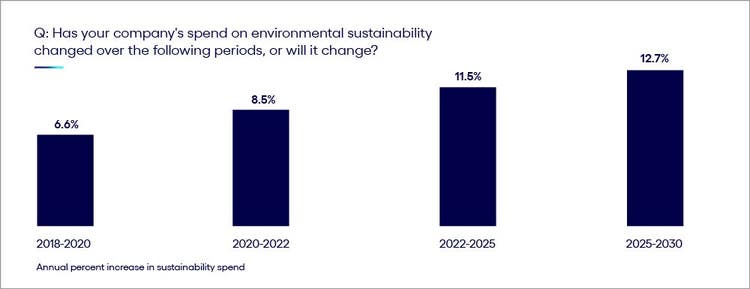
#
<p><span class="small">Source: Cognizant Research<br> Figure 1</span></p> <p>Convinced by the benefits of sustainability-led transformation, businesses across the US have been given the green light to increase investment in their initiatives. Budget growth is expected to increase from an average annual rate of 6.6% between 2018 and 2020 to 12.7% between 2025 and 2030.</p> <h4>#2 Elevate your internally focused sustainability initiatives for even greater returns</h4>
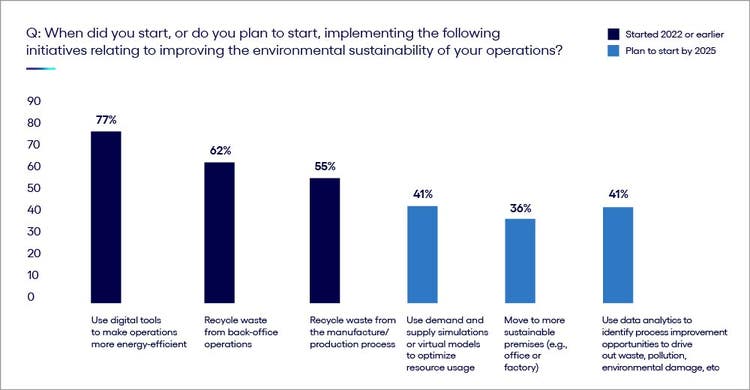
#
<p><span class="small">Source: Cognizant Research<br> Figure 2</span></p> <p>US businesses recognize and have proved that digital tools are catalysts for sustainability transformation, with over three-quarters currently employing them for more energy-efficient operations. Other popular initiatives today focus on recycling waste, both in the back office (62%) and manufacturing (55%) operations.</p> <p>Looking ahead to 2025, a vanguard will intensify their data-driven approaches, such as by creating digital twins to optimize resource management (41%) and leveraging data analytics to identify improvement opportunities (41%).</p> <h4>#3 Expand your sphere of influence, upstream and downstream, to achieve greater business benefits</h4>
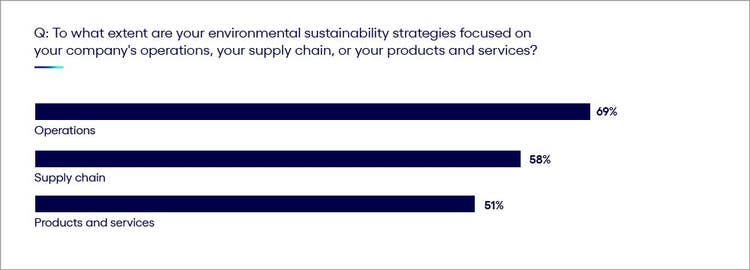
#
<p><span class="small">Source: Cognizant Research<br> Figure 3</span></p> <p>Over two-thirds (69%) of US businesses said their organization’s sustainability strategy is greatly focused on operations, compared with 58% for supply chain and 51% for products and services. This emphasis on internal operations is completely justifiable as it stems from the confidence and control businesses can exert in this area.</p> <p>Conversely, it’s more difficult to effect change in areas traditionally out of their own control, such as the complexities of modern supply chains or the afterlife of a product once in the customer’s hands. Indeed, it is encouraging that 58% are already focusing on their supply chains despite these difficulties and even in the absence of federal legislation covering this area. Unfortunately, it’s far from enough. The good news is that today’s digital technologies can help businesses extend their reach, providing visibility and influence across the entire value chain when deployed effectively.</p> <h4>#4 Explore new ways to apply and deploy mature and emerging technology</h4>
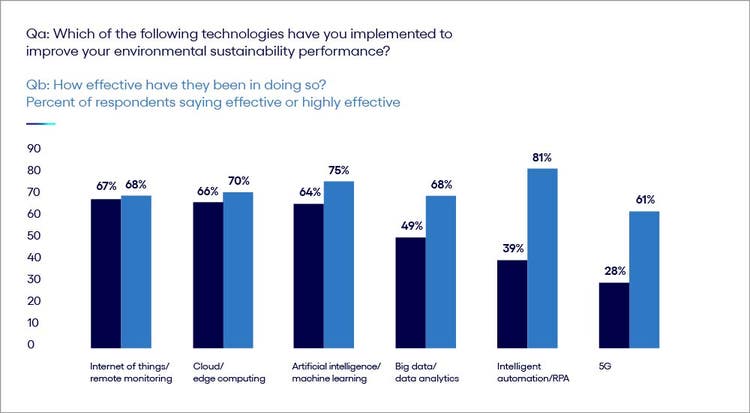
#
<p><span class="small">Source: Cognizant Research<br> Figure 4</span></p> <p>US businesses have deployed a core set of technologies to bolster sustainability transformation: IoT (67%), cloud (66%) and artificial intelligence (64%). However, respondents believe less commonly implemented technologies may also have substantial impact. Although only 39% of businesses in the US have applied intelligent automation to boost their sustainability efforts, for instance, 81% of those that have say it’s effective or highly effective.</p> <p>Given the critical foundations to all sustainability strategies that data provides, it’s great to see that nearly 70% of users recognize data analytics as effective/very effective, but the question is why only 49% of companies have begun to exploit its potential.</p> <h4>#5 Evolve power structures to allow for necessary shifts in culture and accountability</h4>
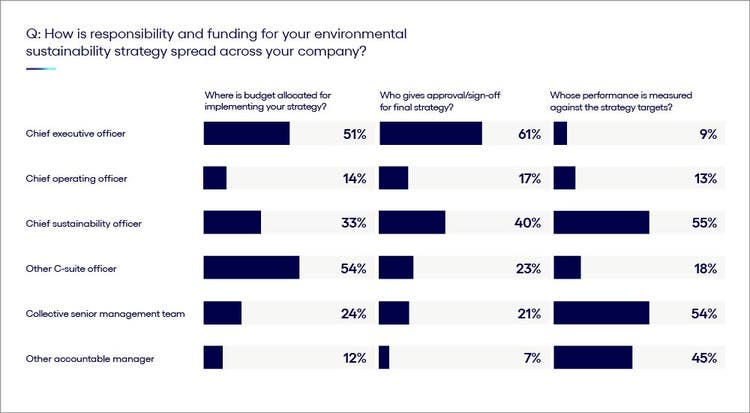
#
<p><span class="small">Source: Cognizant Research<br> Figure 5</span></p> <p>While over half of CEOs provide budget and sign-off for their sustainability strategy, only one in 10 are accountable or have their performance measured against the strategy’s success. Instead, it’s the Chief Sustainability Officer (CSO) and other managers who are responsible for outcomes, despite their absence at the strategy table.</p> <p>To embed sustainability into company culture, businesses must become more deliberate about the structure of roles and responsibilities that will lead to “Deep Green” leadership, as well as clearly connect these to an incentives system to encourage senior leaders and all employees to participate in sustainability endeavors.</p> <p>Businesses also need to push awareness of sustainability and encourage fluency around the theme. This includes nurturing a deep understanding of relevant risks to the enterprise and its stakeholders, as well as clearly communicating the business’s strategy, targets and initiatives, to all levels of the organization. These efforts should all be part of a rigorous change management initiative and that also equips employees with new sustainability-related skills through training and upskilling programs.</p> <p><i>Learn how your business (or you) can become sustainable to the core </i><a href="https://www.cognizant.com/us/en/insights/perspectives/sustainability-in-business-beyond-green-to-deeply-green-wf1518050" target="_blank" rel="noopener noreferrer"><i>in our report</i></a><i> “Deep Green: How data, technology and collaboration will drive the next phase of sustainability in business.”</i></p> <p><i>For even more on this topic, visit our </i><a href="https://www.cognizant.com/us/en/insights/sustainability-resilience" target="_blank" rel="noopener noreferrer"><i>Sustainability & Resilience webpage</i></a><i>. </i></p>
<p>Michael Valocchi is responsible for crafting the overall strategic plan for Cognizant Consulting, bringing together the market elements, commercial offerings and advisory capabilities into a cohesive strategy, including the overall M&A strategy.</p> <p><a href="mailto:FrancisMichael.Valocchi@cognizant.com">FrancisMichael.Valocchi@<br> cognizant.com</a><br> </p>
<p>Philip Smith has spent over 20 years supporting clients in multiple vertical and geographic markets and addressing their sustainability challenges through the lenses of policy, regulation, strategy, technology and organizational change.</p> <p><a href="mailto:Philip.Smith@cognizant.com">Philip.Smith@cognizant.com</a></p>


